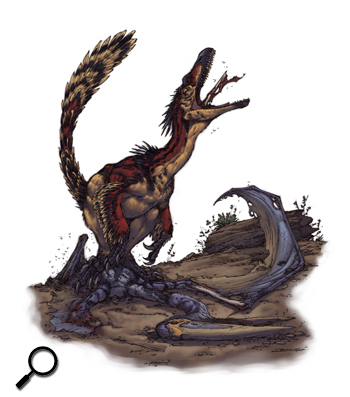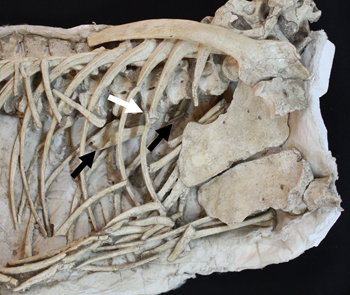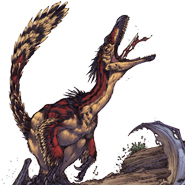Posted 08 March 2012
Ancient fossil remains reveal Velociraptor's last meal
Scientists have discovered a bone from a pterosaur (giant flying reptile or ‘pterodactyl’) in the guts of the skeletal remains of a Velociraptor (small predatory theropod dinosaur) that lived in what is now the Gobi Desert in Mongolia some 75 million years ago.
The findings published online in Palaeogeography, Palaeoclimatology, and Palaeoecology, support the idea that Velociraptor, a carnivore with a specialised sickle shaped slashing talon on the second toe of each foot and large grasping hands, would also scavenge on available carcasses rather than turn down a free meal.
They also indicate that small non-avian dinosaurs were capable of consuming relatively large bones, something that we see in modern crocodiles.

Artist’s impression of a Velociraptor scavenging the carcass of a Pterosaur. Credit: Brett Booth
The international research team involved scientists from University College Dublin, Ireland; the National Museum of Nature and Science, Tokyo, Japan; the Museum of Natural Sciences, Okayama, Japan; and the Mongolian Academy of Sciences, Ulaanbaatr, Mongolia.
“It would be difficult and probably even dangerous for the small theropod dinosaur to target a pterosaur with a wingspan of 2 metres or more, unless the pterosaur was already ill or injured,” says Dr David Hone, one of the co-authors of the study, who was based at the UCD School of Biology and Environmental Sciences, University College Dublin, Ireland, at the time of the analysis.
“So the pterosaur bone we’ve identified in the gut of the Velociraptor was most likely scavenged from a carcass rather than the result of a predatory kill.”

Image of Velociraptor fossil showing the 75 mm long pterosaur bone in the gut (black arrows) and where the rib cage was broken (white arrow).
Credit: David Hone
The fossil, originally recovered from the Gobi Desert in 1994, shows the well preserved 75 mm long pterosaur bone lodged in the upper part of the Velociraptor ribcage where its stomach would have been.
“The surface of the bone is smooth and in good condition, with no unusual traces of marks or deformation that could be attributed to digestive acids,” says Dr Hone.
“So it’s likely that the Velociraptor itself died not long after ingesting the bone.”
Further analysis of the skeletal remains of the Velociraptor showed that it was carrying, or recovering from, an injury to its ribs when it died.
This is the first time that bones from a pterosaur have been uncovered as gut contents from dinosaur remains.
(Produced by UCD University Relations)

